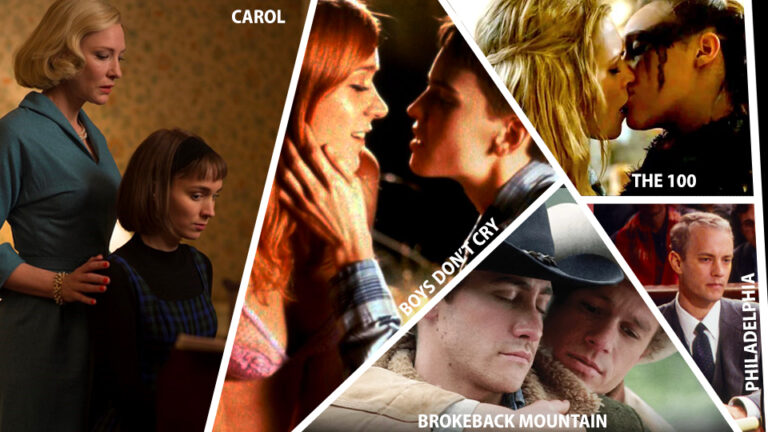By Ava Sinclair
In 2005, an interviewer asked actor Heath Ledger how he’d respond to those who found his latest film “disgusting.” The film in question was Brokeback Mountain, a groundbreaking movie about two Wyoming cowboys who fall in love in a time and culture where homosexuality is considered taboo.
Ledger’s answer was pointed. “I think it’s an incredible shame that people go out of their way to voice their disgust or negative opinions against the ways in which two people choose to love each other,” Ledger replied.
Heath Ledger sadly passed away in 2008, but Brokeback Mountain lives on a one of movies that kicked off a period of increased visibility for LGBTQ characters in mainstream cinema.
The history of LGBTQ representation in movies is a complex one, marked by significant progress and setbacks. From early films that hinted at queer themes and subtext to contemporary works that feature openly LGBTQ characters, the evolution of LGBTQ characters in cinema reflects both the cultural shifts and struggles surrounding sexuality and identity.
During the 1930’s and 1940’s, the Motion Picture Production Code strictly enforced strict guidelines that prohibited any explicit reference to homosexuality. By the 1950’s and 1960’s, those standards had become more relaxed and homosexual representation began appearing in movies, but not in a positive way. Films like Rebel Without a Cause and Suddenly Last Summer included gay characters, but always as villains or deviants. In the 1961 drama The Children’s Hour, homosexuality is presented as the road to ruin when two women are exposed as lesbians, and one ultimately commits suicide.
While more queer themes began to show up in films through the 1970’s and 1980’s, it wasn’t until the 1990’s that movies with gay representation began to show the potential for critical and commercial success. However, blockbusters like Philadelphia and Brokeback Mountain continued to tie queerness to victimization and suffering, an ongoing trope that continues to draw criticism from gay advocates today. In 2016, the popular television series The 100 drew such fan outrage for the killing of the show’s lesbian characters that the producers were forced to issue a public apology.
Queerness has found a more open reception in the adult film industry, but for different reasons. Porn featuring homosexuals became popular in the seventies, but the focus was strictly on objectifying queerness. Lesbian sex was presented as a male fantasy, and male homosexuality featuring muscular men engaged in explicit sex acts. While this content may have been groundbreaking for the LGBTQ community, it emphasized hypermasculinity of gay men and the fetishization of certain body types.
By the 1980’s and 1990’s trans pornography gained popularity with audiences, featuring both transwomen and transmen, but because the primary audience was cisgendered, heterosexual males, once again the actors and their body parts were fetishized.
In recent years, audience demands for more diverse and inclusive LGBT representation has led to the emergence of movies with more sensitive and nuanced storylines. Boys Don’t Cry offered a painful dramatization of a real-life transgender man murdered in Nebraska. Call Me By Your Name told the story of two young gay men who become lovers, and Carol told the story of two women involved in a lesbian relationship.
In the adult film industry, critics continue to complain about representation, with some still complaining that even the most sensitive lesbian porn is still shot with an eye for the male gaze, while films featuring gay men rely too heavily on toxic tropes of gay men seducing straight men in a manner that plays into the stereotype of homosexuals as predators.
LGBTQ advocates, while pleased with the increased improvements of gay and lesbian representation in mainstream cinema, still agree that there is much work left to do. LGBTQ people are still underrepresented in film, or represented in a way that invites stereotypes. The adult film industry remains more problematic but has the potential to play a positive role in LGBTQ representation By creating more diverse and inclusive content that accurately reflects the experience of LGBTQ individuals, adult filmmakers can help break down harmful stereotypes and promote greater acceptance and understanding.


